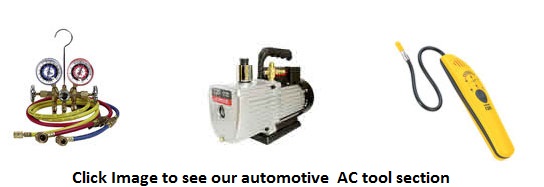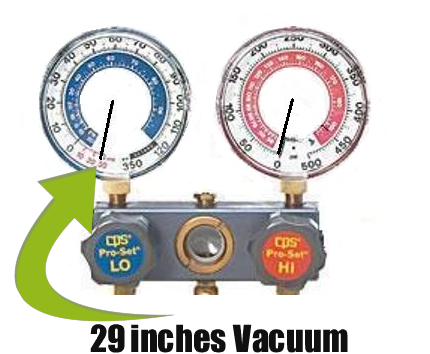Car AC Vacuum Pumps – FAQ’s
May 11, 2012 1:47 pm Air Conditioning© DenLorsTools.com Summary: Florida ASE Master Tech explains what automotive AC vacuum pumps are used for and answers frequently asked questions regarding their practical use when servicing car air conditioning.
With more than twenty five years of experience in the field, I’ve spent most of my time working on cars in the service bay. I hold certifications and have attended numerous training classes throughout the years. Understanding the theory of how a car air conditioning system works is very helpful when diagnosing problems beyond an obvious leak; hands on experience is priceless when applying theory to real car repair situations. In this and our other AC articles, I share some of what I’ve learned fixing “car AC” systems in Florida’s hot climate.
What a Vacuum Pump Does
One very helpful and necessary tool when doing AC work is a vacuum pump. A/C Vacuum pumps are used to pull moisture out of a system. More specifically, a vacuum pump is used to first, pull air out of a closed AC system and then create a vacuum or negative pressure. The lower the pressure in the system, the lower the boiling point is of any water or moisture that’s inside the closed system. To put it simply, air and moisture in an AC system will cause problems. Moisture can freeze-up and air does not work in place of refrigerant. Air in the system can cause compressor noise and over-all inefficiency of the system. The idea is to make the system void of air, boil the moisture and draw it out using the vacuum pump.
Vacuum readings are measured most commonly with a combination manifold A/C gauge. An A/C manifold gauge set will not only display high and low side readings, it will also provide a vacuum reading when a system is held in “vacuum”. See the image at the top of the article which shows a reading on the blue gauge below zero. The vacuum is measured on most AC manifold gauge sets between zero and 30 inches of Mercury (inHG). The closer to 30 the better. A most precise way of measuring vacuum can be done with a micron gauge. A micron gauge is more precise because the units of measurement are much smaller and the gauge itself reads digitally as opposed to an analog reading. A micron gauge is particularly helpful when testing a vacuum pump’s performance since even small variations can easily be seen.
Question – Can I use a vacuum pump to remove the old refrigerant?
Answer – No. If the system has refrigerant in it, the only legal way to discharge it (intentionally) is with a recovery unit. Most shops use RRR (Recover, Recycle & Recharge) machines to do this properly. Furthermore, damage will occur to the vacuum pump if it is used to remove refrigerant.
Question – How do I know if there’s Freon in the system?
Answer – A gauge reading of anything above zero indicates there’s refrigerant in the system. Although a system without anything in it may build up slight pressure (6-10 pounds) due to an increase of outside temperature.
Question – How many inches of vacuum should I pull when vacuuming a system?
Answer – The vacuum reading should read between 28-30. Gauges may be off slightly and they may read a little differently but that’s the reading I would look for.
Question – What does it mean when I turn the vacuum pump off and the vacuum reading does NOT stay between 28-30?
Answer – This means there is a leak. The leak may be in the car’s AC system, a loose hose fitting going to the AC manifold gauge set or a hose seal. Don’t automatically assume that the system has a leak.
Question – What’s the purpose of the vacuum pump to begin with?
Answer – Using a vacuum pump on a system drastically reduces the boiling point of moisture in the system and draws it out. Water normally boils at 212 degrees, however under 29 inches of vacuum water boils at 80 degrees Fahrenheit.
Question – Why worry about moisture in the system?
Answer – Moisture in an AC system can freeze and cause the system to “freeze up” and stop working. Also, moisture under pressure with refrigerant can cause a corrosive acid which may cause leaks in components like evaporators and condensers from within. The acid can eat away (or erode) the aluminum or copper from the inside out.
Question – How does moisture get into the AC system?
Answer – Moisture can get into the system with air when taking components off or when there’s a leak in the system. The desiccant in drier (or accumulator) is designed to help retain moisture as well. The desiccant can however become saturated or restricted by debris filtered through it. It’s recommended to replace the drier or accumulator when ever the the system is opened for service.
Question – How do you hook up an AC vacuum pump to a car’s A/C system?
Answer – A good understanding of how to use AC gauges is needed before using a vacuum pump. We have a previous article on basic AC gauge set use that I recommend reading. It also provides basic vacuum pump hook up and use instructions. If you are already familiar with using a manifold AC gauge set and want to learn more about readings and what they mean, see our article on AC Gauge Readings Explained.
Question – How long does the vacuum pump need to run for?
Answer – This is a question that even AC certified technicians such as myself disagree on. The minimum is 15 minutes, the longer the better. A recent article I read in an AC trade magazine discusses “how much vacuum is enough?” in great lengths. They say to keep the vacuum pump on long enough to achieve vacuum measured below 1,000 microns (preferably down to 500. This is nice to know in theory, however most technicians have analog AC gauges which measure vacuum in inches of Mercury (inHg).
Question – Can I use the vacuum reading to tell if the vehicle’s AC system has a leak?
Answer – Yes. If the leak is a large one the vacuum may not reach 29 on the vacuum gauge. The needle on the gauge will also go back up to zero quickly when the vacuum pump is turned off. If there’s no large leak, the vacuum gauge reading should stay at 29. This is just a quick preliminary test and is not substitute for checking for leaks with an electronic leak detector.
Related Repair Articles and Products


dwayne :
Date: July 8, 2016 @ 6:30 pm
When trying to pull a vacuum on a 2001 Nissan pathfinder the low side hose collapses is this normal? should the hose be replaced?
dennisb - Auto Tool Sales :
Date: July 11, 2016 @ 8:02 am
Hose needs to be replaced.